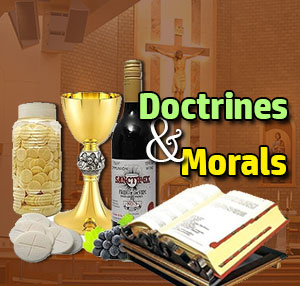THE CHAIR OF ST PETER, THE APOSTLE
THE WORD “CHAIR” derives from the Latin sedes, that is, the Holy See, or the Greek expression Cathedra Sancti Petri. The chair honoured by the Mother Church today is the one that was actually used by St Peter in the catacombs of St Priscilla. It is a plain oak armchair, with legs connected by crossbars to strengthen it. In the course of time, other supports were added to it, but it remains in form and substance the chair occupied by St Peter when he instructed the early Christians, the chair before which they knelt when he administered to them the Sacrament of Confirmation.
For many years, the chair was exposed to the public gaze and was especially venerated on the feast day. Moreover, each newly elected Pope was solemnly enthroned on it. However, later it was deemed necessary, in order to preserve it, to enclose it in metal, Now set high up in the walls of the apse of St Peter’s basilica at the Vatican, the chair, embellished with ivory panels and enclosed in bronze casing designed by Bernini, was last exposed for public veneration in 1867, commemorating the 18th centenary of the great Apostle’s martyrdom.
The feast implicitly affirms Catholic teaching concerning the papacy: in the reigning pope the Church recognises and honours legitimate successor of St Peter as Pastor of the whole Church. This is the origin of the expression ex cathedra - “from the chair” - referring to papal pronouncements (very rarely made) whereby the pope infallibly defines a doctrine that is irrevocably binding on all the faithful, Vox Papae, Vox Petri.
It is by the power that comes from God and not by his own attitude that St Peter is made the sure reference point of our apostolic faith. Did the Lord not say to Peter, “I have prayed for you that your faith may not fail; and you in your turn strengthen your brothers” (Lk 22: 32)? St Peter remains the unshakeable rock of the Church.
In fact, St Peter is often pictured with a great key in his hand, the symbol of his authority. “I now say to you, you are Peter, and upon this rock I will build my Church, and the gates of the underworld shall never prevail against it. I will give you the keys of the kingdom of Heaven. Whatever you bind on earth shall be bound in heaven and whatever you loose on earth shall be loosed in heaven” (Mt 16: 18-19). With this little declaration, Jesus invested Peter with the right to sit in the place as the Prince of the Apostles, giving him, as he did so, servant-authority over the whole Church. It is the Episcopal dignity and universal primacy of that high office instituted by our Lord himself that we venerate rather than the worm-eaten oak-wood arm-chair supposedly used by Peter.
Peter was the prince of the Apostles and the first Pope. After Jesus went back to heaven, Peter, strengthened by the gift of the Holy Spirit, preached the Gospel and ruled the Church as Jesus had commanded. At first, he laboured in Antioch and in Jerusalem. Later, he preached the Gospel in Rome, the great capital of the then known world. Although a wicked pagan city, Peter converted many with the power of the Risen Lord.
Peter and Paul were in the East when they learned of the persecution that had broken out under Nero against the Church of Rome. They were on their way to visit the faithful of the Eternal City, of the principle Church in order to comfort, sustain and console them. They fell into the hands of the persecutors. They were condemned to death. Both walked together praising God. At a certain spot, they were commanded to separate. The faithful erected a little chapel, called the Church of Kiss.
St Paul said to the Head of the Church: “Peace be with you, Foundation of the Church and Shepherd of the flock of Christ!” St Peter answered Apostle Paul: “Go in peace, preacher of good works, mediator and herald of the salvation of the just!” St Peter as crucified on Vatican Hill. He requested the persecutors to crucify him downward, because he felt himself unworthy to die head upward like his Lord and Master!
The Feast of St Peter’s Chair has been celebrated in Rome from the 4th century onwards, as an expression of the unity of the Church. The chair of Peter means the office of Peter and his successors. Therefore, this is the feast of the Holy See. The feast offers us a catechesis on the role of the Apostle Peter. Celebrating the Eucharist, the sacrament of munity and peace, we relate ourselves to Peter’s ministry of unity in the church, for he is the visible guarantor of this unity.
The pastoral heart of Apostle Peter is clearly seen in his advice to the elders of the Church.... “Be the shepherds of the flock of God entrusted to you, watch over it, not simply as a duty but gladly, because God wants it; not for sordid money, but because you are eager to do it. Never be a dictator over any group that is put in y our charge, but an example that the whole flock can follow. When the Chief Shepherd appears, you will be given the crown of unfading glory” (1 Peter 5: 1-4).
St Irenaeus of Lyons says that the Church of Rome founded by Peter and Paul, is a guarantee of authentic of faith, on account of her episcopal succession and of her doctrine. Peter was not only the founder of the Church of Rome, he is also always present in it in the person of his successor.
St Leo the Great states: “One man, Peter, was chosen from the whole world to preside over the calling of all nations, over all the apostles and all the fathers of the Church ... by his appointment, God conferred on this man a great and wonderful share in His power.”
Blessed James Alberione states: “St Peter gained the palm of martyrdom at Rome where he had established for himself and his successors the See of the Vicar of Christ ... The Church is the people of God. May all be faithful! May all believe in what the church preaches! May all follow her moral teachings and the Christian virtues!”
Vatican Council II says: “The successors of the Apostles, together with the successor of Peter, the Vicar of Christ, the visible head of the whole Church, govern the house of the living God” (LG 18). Let us ask ourselves how lovingly we listen to the voice of the Pope and how faithfully we follow his teachings and obey his instructions. He is the Vicar of Christ. To listen to him is to listen to Christ. Fidelity to him is fidelity to Christ.
It is our duty to thank God for the institution of the Petrine ministry and for establishing the permanent Apostolic See to teach, govern and sanctify the faithful of Christ. Our present Holy Father, successor of Peter, has the care of all the Churches and carries the heavy burden of his office and deserves our love, obedience, respect and support. He spends his time and energy working for us, and we must strengthen him through our prayers. God, our Father, you have built your Church on the rock of St Peter’s confession of faith. May nothing divide or weaken our unity in faith and love. Amen.
© 2024 - Catholic Archdiocese of Ibadan





